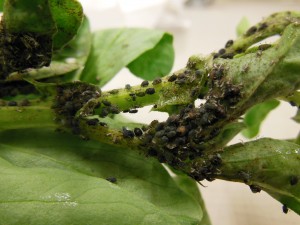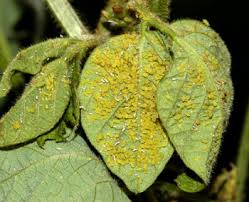Aphids
Aphids are a common pest in our gardens and they affect almost all plants. May it be gourds or pods or ornamentals aphids thrive on them. They are seen in different colours from black to yellow, orange and in green or brown shades. They have a proliferative life pattern and that is why we see them in very large numbers.
life cycle
Their life cycle involves wingless females giving living birth to female innumerable nymphs without mating with males. The nymphs mature rapidly. These females breed profusely in the same pattern so that the number of these insects multiplies quickly.
Winged females may develop later in the season, allowing the insects to colonise new plants flying off.
Before the start of unfavorable season a phase of sexual reproduction is initiated and eggs thus formed are laid in safe places which will carry their generation thru the bad times and hatch when favourable conditions return.
Ants and Aphids have a symbiotic relationship.
The ants carry and herd them up to the tips of some plants where they are protected and allowed to multiply. The ants tickle the aphids which squirts a liquid from its tail end hoping to discourage the irritating ants. Unfortunately that liquid happens to be very sweet and is called Honey dew!! Ants enjoy that and so keeps tickling!! This continues ..the aphids drain our plant’s sap and feed the ants…and infact ants rear these colonies like we have cows, for their food.. ants protect them from other predators too.
But ladybird beetles have a way out of this which ants do not know. The adult beetles eat the aphids when they see them. They quickly lays eggs after mating and if you carefully watch the under side of the leaves , you can see tuft of yellow eggs . These hatch and comes out as tail less alligator like larvae..some will have thin white soft furl which disappears when they molt a few times.
These are voracious eaters and they continuously feed on the aphid population till they are exhausted. When they reach full growth they move to some safe corner of the leaves or stem and turn into pupa stage ..this is a non feeding stage. In a few days the pupa rapture and the young adult come out to continue its attack on our irritant pest!
While they do such a great job free of cost for us, we carelessly kill these friendly insects by spraying insecticides and repellants.
I always write telling my farming friends and gardners not to use harsh sprays on aphids. The reason is, we simply kill the friends for no reason. Instead if we use a diluted spray of soap nut water the ladybird larvae or its eggs or adults will not be badly affected. The thin skinned aphids crumble when soapnut water dries up. And still they will be eaten by the larvae. We will still have them work for us.
Anoop Kumar C.P


Showing all 3 resultsSorted by popularity



